Hand fan
A handheld fan, or simply hand fan, may be any broad, flat surface that is waved back-and-forth to create an airflow. Generally, purpose-made handheld fans are folding fans, which are shaped like a sector of a circle and made of a thin material (such as papel or feathers) mounted on slats which revolve around a pivot so that it can be closed when not in use.
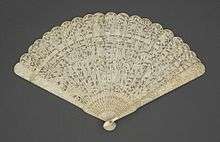
On human skin, the airflow from handfans increases evaporation which has a cooling effect due to the latent heat of evaporation of water. It also increases heat convection by displacing the warmer air produced by body heat that surrounds the skin, which has an additional cooling effect, provided that the ambient air temperature is lower than the skin temperature – which is typically about 33 °C (91 °F). Fans are convenient to carry around, especially folding fans.
Next to the folding fan, the rigid hand screen fan was also a highly decorative and desired object among the higher classes. Its purpose is different since they are more cumbersome to carry around. They were mostly used to shield a lady's face against the glare of the sun or the fire.
History
Europe
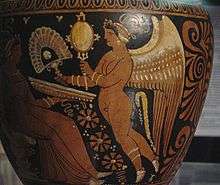
.jpg)
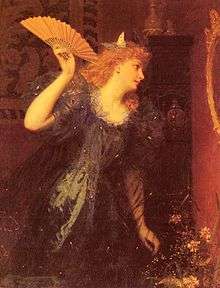
Archaeological ruins and ancient texts show that the hand fan was used in ancient Greece at least from the 4th century BC and was known as a rhipis (Greek: ῥιπίς).[1]
Christian Europe's earliest known fan was the flabellum (ceremonial fan), which dates from the 6th century. It was used during services to drive insects away from the consecrated bread and wine. Its use died out in western Europe, but continues in the Eastern Orthodox and Ethiopian Churches.
Hand fans were absent from Europe during the High Middle Ages until they were reintroduced in the 13th and 14th centuries. Fans from the Middle East were brought by Crusaders, and refugees from the Byzantine Empire. Portuguese traders brought them from China and Japan in the 16th century, and fans became generally popular.
The fan became especially popular in Spain, where flamenco dancers used the fan and extended its use to the nobility.
European fan-makers have introduced more modern designs and have enabled the hand fan to work with modern fashion.
Early Modern Period
In the 17th century the folding fan, and its attendant semiotic culture, were introduced from Japan. Simpler fans were developed in China, Greece, and Egypt. Japanese fans (and Chinese imports) became popular in Europe. These fans are particularly well displayed in the portraits of the high-born women of the era. Queen Elizabeth I of England can be seen to carry both folding fans decorated with pom poms on their guardsticks as well as the older style rigid fan, usually decorated with feathers and jewels. These rigid style fans often hung from the skirts of ladies, but of the fans of this era it is only the more exotic folding ones which have survived. Those folding fans of the 15th century found in museums today have either leather leaves with cut out designs forming a lace-like design or a more rigid leaf with inlays of more exotic materials like mica. One of the characteristics of these fans is the rather crude bone or ivory sticks and the way the leather leaves are often slotted onto the sticks rather than glued as with later folding fans. Fans made entirely of decorated sticks without a fan 'leaf' were known as brisé fans. However, despite the relative crude methods of construction folding fans were at this era high status, exotic items on par with elaborate gloves as gifts to royalty.
In the 17th century the rigid fan which was seen in portraits of the previous century had fallen out of favour as folding fans gained dominance in Europe. Fans started to display well painted leaves, often with a religious or classical subject. The reverse side of these early fans also started to display elaborate flower designs. The sticks are often plain ivory or tortoiseshell, sometimes inlaid with gold or silver pique work. The way the sticks sit close to each other, often with little or no space between them is one of the distinguishing characteristics of fans of this era.
In 1685 the Edict of Nantes was revoked in France. This caused large scale immigration from France to the surrounding Protestant countries (such as England) of many fan craftsman. This dispersion in skill is reflected in the growing quality of many fans from these non-French countries after this date.
In the 18th century, fans reached a high degree of artistry and were being made throughout Europe often by specialized craftsmen, either in leaves or sticks. Folded fans of silk, or parchment were decorated and painted by artists. Fans were also imported from China by the East India Companies at this time. Around the middle 18th century, inventors started designing mechanical fans. Wind-up fans (similar to wind-up clocks) were popular in the 18th century. In the 19th century in the West, European fashion caused fan decoration and size to vary.
It has been said that in the courts of England, Spain and elsewhere fans were used in a more or less secret, unspoken code of messages[2] These fan languages were a way to cope with the restricting social etiquette. However, modern research has proved that this was a marketing ploy developed in the 19th century (FANA Journal, spring 2004, Fact & Fiction about the language of the fan by J.P. Ryan) - one that has kept its appeal remarkably over the succeeding centuries. This is now used for marketing by fan makers like Cussons & Sons & Co. Ltd who produced a series of advertisements in 1954 showing "the language of the fan" with fans supplied by the well known French fan maker Duvelleroy.
The rigid or screen fan (éventail a écran) became also fashionable during the 18th and 19th century. They never reached the same level of popularity as the easy to carry around, folding fans which became almost an integrated part of women's dress. The screen fan was mainly used inside the interior of the house. In 18th and 19th century paintings of interiors one sometimes sees one laying on a chimney mantle. They were mainly used to protect a woman's face against the glare and heat of the fire, to avoid getting 'coup rose' or ruddy cheeks from the heat. But probably not in the least it served to keep the heat from spoiling the carefully applied make-up which in those days was often wax-based. Until the 20th century houses were heated by open fires in chimneys or by stoves, and the lack of insulation made many a house very draughty and cold during winter. Therefore, any social or family gathering would be in close proximity to the fireplace.
The design of the screen fan is a fixed handle, most often made out of exquisitely turned (painted or guided) wood, fixed to a flat screen. The screen could be made out of silk stretched on a frame or thin wood, leather or papier mache. The surface is often exquisitely painted with scenes ranging from flowers and birds of paradise to religious scenes. At the end of the 19th century they disappeared when the need for them ceased to exist. During the 19th century names like the Birmingham-based firm of Jennens and Bettridge produced many papier-mâché fans.
East Asia
Chinese hand fan
The oldest existing Chinese fans are a pair of woven bamboo, wood or paper side-mounted fans from the 2nd century BC.[3] The Chinese character for "fan" (扇) is probably derived from a picture of feathers under a roof. A particular status and gender were associated with a specific type of fan. During the Song dynasty, famous artists were often commissioned to paint fans. The Chinese dancing fan was developed in the 7th century. The Chinese form of the hand fan was a row of feathers mounted in the end of a handle. In later centuries, Chinese poems and four-word idioms were used to decorate fans, using Chinese calligraphy pens. In ancient China, fans came in various shapes and forms (such as in a leaf, oval or a half-moon shape), and were made in different materials such as silk, bamboo, feathers, etc.[4]
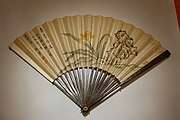 Folding fan painted by the Qianlong emperor for Empress Dowager Chongqing, China, 1762 AD.
Folding fan painted by the Qianlong emperor for Empress Dowager Chongqing, China, 1762 AD. A portrait of a lady holding a rigid (oval) fan from the painting "Appreciating Plums", by Chinese artist Chen Hongshou
A portrait of a lady holding a rigid (oval) fan from the painting "Appreciating Plums", by Chinese artist Chen Hongshou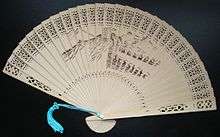 A typical, commercially produced scented wood folding fan, featuring a drawing of the Great Wall of China
A typical, commercially produced scented wood folding fan, featuring a drawing of the Great Wall of China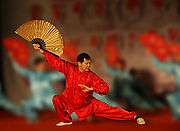 Chinese foldable fans are also used to do the performance of Kung Fu
Chinese foldable fans are also used to do the performance of Kung Fu
Japanese hand fan
In ancient Japan, hand fans, such as oval and silk fans, were influenced greatly by Chinese fans.[5] The earliest visual depiction of fans in Japan dates back to the 6th century AD, with burial tomb paintings showed drawings of fans. The folding fan was invented in Japan, with date ranging from the 6th to 9th centuries.[6][7][8][9] It was a court fan called the Akomeogi (衵扇, Akomeōgi) after the court women's dress named Akome.[6][10] According to the Song Sui (History of Song), a Japanese monk Chonen (奝然, Chōnen, 938-1016) offered the folding fans (twenty wooden-bladed fans hiogi (桧扇, hiōgi) and two paper fans kawahori-ogi (蝙蝠扇, kawahori-ōgi) to the emperor of China in 988.[8][9][11] Later in the 11th century, Korean envoys brought along Korean folding fans which were of Japanese origin as gifts to Chinese court.[12] The popularity of folding fans was such that sumptuary laws were promulgated during Heian period which restricted the decoration of both hiogi and paper folding fans.[11][13]
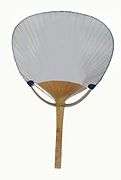 Japanese rigid fan (uchiwa)
Japanese rigid fan (uchiwa).png) Japanese foldable fan (sensu)
Japanese foldable fan (sensu)- Japanese foldable fan of late-Heian period (c. 12th century)
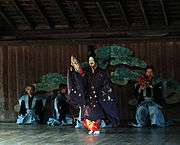 Traditional Japanese ceremony at Itsukushima Shrine
Traditional Japanese ceremony at Itsukushima Shrine
They were made by tying thin stripes of hinoki (or Japanese cypress) together with thread. The number of strips of wood differed according to the person's rank. Later in the 16th century, Portuguese traders introduced it to the west and soon both men and women throughout the continent adopted it.[7] They are used today by Shinto priests in formal costume and in the formal costume of the Japanese court (they can be seen used by the Emperor and Empress during enthronement and marriage) and are brightly painted with long tassels. Simple Japanese paper fans are sometimes known as harisen.
Printed fan leaves and painted fans are done on a paper ground. The paper was originally handmade and displayed the characteristic watermarks. Machine-made paper fans, introduced in the 19th century, are smoother, with an even texture. Even today, Geisha of all types (but maiko most often) use folding fans in their fan dances as well.
Japanese fans are made of paper on a bamboo frame, usually with a design painted on them. In addition to folding fans (ōgi),[14] the non-bending fans (uchiwa) are popular and commonplace.[15] The fan is primarily used for fanning oneself in hot weather. The uchiwa fan subsequently spread to other parts of Asia, including Burma, Thailand, Cambodia and Sri Lanka, and such fans are still used by Buddhist monks as "ceremonial fans".[16]
It was also used in the military as a way of sending signals on the field of battle. However, fans were mainly used for social and court activities. In Japan, fans were variously used by warriors as a form of weapon, by actors and dancers for performances, and by children as a toy.
Traditionally, the rigid fan (also called fixed fan) was the most popular form in China,[17] although the folding fan came into popularity during the Ming Dynasty between the years of 1368 and 1644, and there are many beautiful examples of these folding fans still remaining.[18]
The Mai Ogi (or Japanese dancing fan) has ten sticks and a thick paper mount showing the family crest, and Japanese painters made a large variety of designs and patterns. The slats, of ivory, bone, mica, mother of pearl, sandalwood, or tortoise shell, were carved and covered with paper or fabric. Folding fans have "montures" which are the sticks and guards, and the leaves were usually painted by craftsmen. Social significance was attached to the fan in the Far East as well, and the management of the fan became a highly regarded feminine art. Fans were even used as a weapon - called the iron fan, or tessen in Japanese.
Categories
Hand fans have three general categories:
- Fixed (or rigid, flat) fans (Chinese: 平扇, píng shàn; Japanese: 団扇, uchiwa, cannot be folded): circular fans, palm-leaf fans, straw fans, feather fans, etc.
- Folding fans (Chinese: 折扇, zhé shàn; Japanese: 扇子, sensu, can be freely opened): silk folding fans, paper folding fans, sandalwood fans, etc.
- Modern powered mechanical hand fans: these are hand fans which, unlike most, appear as mini mechanical rotating fans with blades. These are usually axial fans, and often use blades made from a soft material for safety. These are usually battery operated, but can be hand cranked as well.
 Japanese foldable fan: Painted by Hokusai.
Japanese foldable fan: Painted by Hokusai. Japanese "Kamon"
Japanese "Kamon" Fig. 3. Bengalese fans used in Indian homes.
Fig. 3. Bengalese fans used in Indian homes.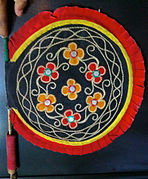
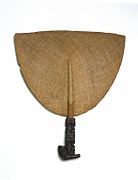 Fan (Tahi'i), 19th century, Marquesas Islands, French Polynesia. Plant fibre, wood. Brooklyn Museum.
Fan (Tahi'i), 19th century, Marquesas Islands, French Polynesia. Plant fibre, wood. Brooklyn Museum. Hand fan crafted of leather from southern Thailand
Hand fan crafted of leather from southern Thailand- Very old ornamental fan from Sri Lanka
See also
Use in dance
- Buchaechum – Korean fan dance
- Cariñosa – national dance of the Philippines
- Singkil – traditional Maranao dance from the Philippines
- Suzume Odori – traditional dance originating from Sendai, Japan
Use as weapons
Use in comedy
Use in politics
- Islami Andolan Bangladesh – an Islamic political party in Bangladesh that uses a hand fan as its electoral symbol
Museums
- Musée de l'Éventail (Paris)
- The Fan Museum in Greenwich (Greenwich, London)
- The Hand Fan Museum in Healdsburg, California
- Museu Tèxtil i d’Indumentària in Barcelona
References
- ῥιπίς, Henry George Liddell, Robert Scott, A Greek-English Lexicon, on Perseus
- "Indecent Fan Proposals - A Nice Gesture by Jeroen Arendsen". jeroenarendsen.nl. 19 June 2006.
- "articles - brief history of fans". aboutdecorativestyle.com.
- "Chinese Hand Fans". hand-fan.org.
- "Japanese Hand Fans". hand-fan.org.
- Halsey, William Darrach; Friedman, Emanuel (1983). Collier's encyclopedia: with bibliography and index. 9. Macmillan Educational Co. p. 556.
In the seventh century the folding fan evolved, the earliest form of which was a court fan called the "Akomeogi", which had thirty-eight blades connected by a rivet; it had artificial flowers at the corners and twelve long, colored silk streamers.
- Lipinski, Edward R. (1999). The New York Times home repair almanac: a season-by-season guide for maintaining your home. Lebhar-Friedman Books. ISBN 0-86730-759-5.
The Japanese developed the folding fan, the Akomeogi, during the sixth century. Portuguese traders introduced it to the west in the 16th century and soon both men and women throughout the continent adopted it.
- Qian, Gonglin (2000). Chinese fans: artistry and aesthetics. Long River Press. p. 12. ISBN 1-59265-020-1.
The first folding fan arrived as a tribute that was brought to China by a Japanese monk in 988. Writings of both Japanese and Chinese scholars concerning the folding fan, which was believed to have been first invented in Japan, apparently suggest that it received its shape from the design of a bat's wing.
- Verschuer, Charlotte von (2006). Across the perilous sea: Japanese trade with China and Korea from the seventh to the sixteenth centuries. Cornell University. p. 72. ISBN 1-933947-03-9.
Another Japanese creation enjoyed great success among foreigners: the folding fans. It was invented in Japan in the eighth or ninth century, when only round and fixed (uchiwa) fans made of palm leaves were known. -- their usage had spread throughout China in antiquity. Two types of folding fans developed: one was made of cypress-wood blades bound by a thread (hiogi); the other had a frame with fewer blades which was covered in Japanese paper and folded in a zigzag patterns (kawahori-ogi).
"The paper fan was described by a thirteenth-century Chinese author, but well before that date Chōnen had offered twenty wooden-bladed fans and two paper fans to the emperor of China." - 衵扇 [Akomeogi] (in Japanese). Mypedia.
- Hutt, Julia; Alexander, Hélène (1992). Ōgi: a history of the Japanese fan. Dauphin Pub. p. 14. ISBN 1-872357-08-3.
It was recorded in the Song Shu, the official history of the Chinese Song dynasty (960-1279), that in 988 a Japanese monk, Chonen, presented at court gifts of...
(Editor's note: Instead of Song Shu (宋書 Book of Song), Song Sui (宋史 History of Song) is correct.)
"There are also numerous references to folding fans in the great classical literature of the Heian period (794-1185), in particular the Genji monogatari (The tale of Genji) by Murasaki Shikibu and the Makura no Sōshi (The pillow book) by Sei Shōnagon. Already by the end of tenth century, the popularity of folding fans was such that sumptuary laws were promulgated during Chōho era (999-1003) which restricted the decoration of both hiogi and paper folding fans." - Tsang, Ka Bo (2002). More than keeping cool: Chinese fans and fan painting. Royal Ontario Museum. p. 10. ISBN 0-88854-439-1.
Guo Ruoxu, for example, has included a short note about the folding fan in his Tuhua Jian Wen Zhi (Records of Paintings Seen and Heard About, 1074) It states that Korean envoys often brought along Korean folding fans as gifts. They were, Guo also pointed out, of Japanese origin.
- Medley, Margaret (1976). Chinese painting and the decorative style. University of London School of Oriental and African Studies, Percival David Foundation of Chinese Art. p. 106. ISBN 0-7286-0028-5.
In origin it was evidently Japanese, common already in the Heian period. A fragment of a late Heian folding-fan was excavated some decade ago at Takao-yama. Japanese fans were well known in China during the late eleventh century.
- Nussbaum, Louis Frédéric et al. (2005). "Ōgi" in Japan Encyclopedia, p. 738., p. 738, at Google Books
- Nussbaum, "Uchiwa," p. 1006., p. 1006, at Google Books
- "Buddhist Monks Ceremonial Fans". Thebuddhasface.co.uk. Retrieved 2017-10-27.
- "fan - decorative arts". Encyclopædia Britannica.
- ChinesePod Weekly, Chinese Fans: More Than Keeping Cool Archived 2012-11-13 at the Wayback Machine
Sources
- Nussbaum, Louis Frédéric and Käthe Roth. (2005). Japan Encyclopedia. Cambridge: Harvard University Press. ISBN 978-0-674-01753-5; OCLC 48943301
Books
- Alexander, Helene. The Fan Museum, Third Millennium Publishing, 2001 ISBN 0-9540319-1-1
- Alexander, Helene & Hovinga-Van Eijsden, Fransje. A Touch of Dutch - Fans from the Royal House of Orange-Nassau, The Fan Museum, February 2008, ISBN 0-9540319-5-4
- Armstrong, Nancy. Book of Fans. Smithmark Publishing, 1984. ISBN 0-8317-0952-9
- Armstrong, Nancy. Fans, Souvenir Press, 1984 ISBN 0-285-62591-8
- Bennett, Anna G. Unfolding beauty: The art of the fan : the collection of Esther Oldham and the Museum of Fine Arts, Boston. Thames and Hudson (1988). ISBN 0-87846-279-1
- Bennett, Anna G. & Berson, Ruth Fans in fashion. Publisher Charles E. Tuttle Co. Inc & The Fine Arts Museums of San Francisco (1981) ISBN 0-88401-037-6
- Biger, Pierre-Henri. Sens et sujets de l'éventail européen de Louis XIV à Louis-Philippe. Histoire of Art Thesis, Rennes 2 University, 2015. (https://tel.archives-ouvertes.fr/tel-01220297)
- Checcoli, Anna. " Il ventaglio e i suoi segreti ", Tassinari, 2009
- Checcoli, Anna. " Ventagli Cinesi Giapponesi ed Orientali ", Tassinari, 2009
- Cowen, Pamela. A Fanfare for the Sun King: Unfolding Fans for Louis XIV, Third Millennium Publishing (September, 2003) ISBN 1-903942-20-9
- Das, Justin. Pankha -Traditional crafted hand fans of the Indian Subcontinent from the collection of Justin Das - The fan museum, Greenwich (2004)
- Faulkner, Rupert. Hiroshige Fan Prints, V&A publications, 2001 ISBN 1-85177-332-0
- Fendel, Cynthia. Novelty Hand Fans, Fashionable Functional Fun Accessories of the Past. Hand Fan Productions, 2006 ISBN 978-0-9708852-1-0
- Fendel, Cynthia. Celluloid Hand Fans. Hand Fan Productions, 2001. ISBN 0-9708852-0-2
- Gitter, Kurt A. Japanese fan paintings from western collections. Publisher - New Orleans Museum of Art (1985). ISBN 0-89494-021-X
- Hart, Avril & Taylor, Emma. Fans (V & A Fashion Accessories Series). Publisher- V & A Publications. ISBN 1-85177-213-8
- Hutt, Julia & Alexander, Helene. Ogi: A History of the Japanese Fan. Art Media Resources; Bilingual edition (February 1, 1992) ISBN 1-872357-08-3
- Irons, Neville John. Fans of Imperial China. Kaiserreich Kunst Ltd, 1982 ISBN 0-907918-00-X
- Letourmy-Bordier, Georgina & Le Guen, Sylvain, L'éventail, matières d'excellence : La nature sublimée par les mains de l'artisan, Musée de la Nacre et de la Tabletterie (September 2015) ISBN 978-2953110692
- Mayor, Susan. A Collectors Guide to Fans, Charles Letts, 1990
- Mayor, Susan. The Letts Guide to Collecting Fans. Charles Letts, 1991 ISBN 1-85238-128-0
- North, Audrey. Australia's fan heritage. Boolarong Publications (1985). ISBN 0-86439-001-7
- Qian, Gonglin. Chinese Fans: Artistry and Aesthetics (Arts of China, #2). Long River Press (August 31, 2004) ISBN 1-59265-020-1
- Rhead, G. Wooliscroft. The History of the Fan, Kegan Paul, 1910
- Roberts, Jane. Unfolding Pictures: Fans in the Royal Collection. Publisher - Royal Collection (January 30, 2006. ISBN 1-902163-16-8
- Tam, C.S. Fan Paintings by Late Ch'ing Shanghai Masters. Publisher - Urban Council for an exhibition in the Hong Kong Museum of Art (1977)
- Vannotti, Franco. Peinture Chinoise de la Dynastie Ts'ing (1644–1912). Collections Baur, Geneve (1974)
See also
External links
![]()
| Wikisource has the text of the 1911 Encyclopædia Britannica article Fan. |
- A visual guide to Victorian fan language, photos by Fabio and Gabrielle Arciniegas
- mm's fan collection with monographies on love symbols on fans, celluloid fans, George Barbier and more
- Hand fan collection Anna Checcoli
- All About Hand Fans with Cynthia Fendel
- Hand Fan Museum
- The Fan Circle International
- Tessen warrior fan
- The Fan Museum in Greenwich, London
- Fan Association of North America
- Fans in the Staten Island Historical Society Online Collections Database
- La Place de l'Eventail (French website dedicated to the European Hand Fan (most pages in English)
- Galerie Le Curieux, Paris
- Fans in the 16th and 17th Centuries
- Variety of Hand Held fans in different colour and styles
- Maison Sylvain Le Guen - contemporary hand fans by Sylvain Le Guen
- Allhandfans - Site entirely dedicated to the hand fan